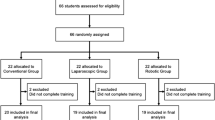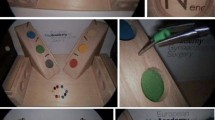Abstract
Technical surgical skills are said to be acquired quicker on a robotic rather than laparoscopic platform. However, research examining this proposition is scarce. Thus, this study aimed to compare the performance and learning curves of novices acquiring skills using a robotic or laparoscopic system, and to examine if any learning advantages were maintained over time and transferred to more difficult and stressful tasks. Forty novice participants were randomly assigned to either a robotic- or laparoscopic-trained group. Following one baseline trial on a ball pick-and-drop task, participants performed 50 learning trials. Participants then completed an immediate retention trial and a transfer trial on a two-instrument rope-threading task. One month later, participants performed a delayed retention trial and a stressful multi-tasking trial. The results revealed that the robotic-trained group completed the ball pick-and-drop task more quickly and accurately than the laparoscopic-trained group across baseline, immediate retention, and delayed retention trials. Furthermore, the robotic-trained group displayed a shorter learning curve for accuracy. The robotic-trained group also performed the more complex rope-threading and stressful multi-tasking transfer trials better. Finally, in the multi-tasking trial, the robotic-trained group made fewer tone counting errors. The results highlight the benefits of using robotic technology for the acquisition of technical surgical skills.




Similar content being viewed by others
References
Dulan G, Rege RV, Hogg DC, Gilbery-Fisher KM, Arain NA, Tesfay ST, Scott DJ (2012) Proficiency-based training for robotic surgery: construct validity workload and expert levels for nine inanimate exercises. Surg Endosc 26:1516–1521. doi:10.1007/s00464-011-2102-6
Reyes DA, Tang B, Cuschieri A (2006) Minimal access surgery (MAS)-related surgeon morbidity syndromes. Surg Endosc 20:1–13. doi:10.1007/s00464-005-0315-2
Smith CD, Farrell TM, McNatt SS, Metrevel RM (2001) Assessing laparoscopic manipulative skills. Am J Surg 181:547–550. doi:10.1016/S0002-9610(01)00639-0
Anderberg M, Larsson J, Kockum CC, Arnbjornsson E (2010) Robotics versus laparoscopy—an experimental study of the transfer effects in maiden users. Ann Surg Innov Res 4:3–9. doi:10.1186//1750-1164-4-3
Yohannes P, Rotariu P, Pinto P, Smith AD, Lee BR (2002) Comparison of robotic versus laparoscopic skills: is there a difference in the learning curve? Adult Urol 60:39–45. doi:10.1016/S0090-4295(02)01717-X
Chang L, Satava RM, Pellegrini CA, Sinanan MN (2003) Robotic surgery: identifying the learning curve through objective measurement of skill. Surg Endosc 17:1744–1748. doi:10.1007/s00464-003-8813-6
Sumi Y, Dhumane PW, Komeda K, Dallemagne B, Kuroda D, Marescaux J (2013) Learning curves in expert and non-expert laparoscopic surgeons for robotic suturing with the da Vinci® surgical system. J Robotic Surg 7:29–34. doi:10.1007/s11701-012-0336-5
Hernandez JD, Bann SD, Munz Y, Moorthy K, Datta V, Martin S et al (2004) Qualitative and quantitative analysis of the learning curve of a simulated surgical task on the da Vinci system. Surg Endosc 18:372–378. doi:10.1007/s00464-003-9047-3
Heemskerk J, van Gemert WG, de Vries J, Greve JW, Bouvy ND (2007) Learning curves of robot-assisted laparoscopic surgery compared with conventional laparoscopic surgery: an experimental study evaluating skill acquisition of robot-assisted laparoscopic tasks compared with conventional laparoscopic tasks in experienced users. Surg Laparosc Endosc Percutan Tech 17:171–174. doi:10.1097/SLE.0b013e31805b8346
Narazaki K, Oleynikov D, Stergiou N (2006) Robotic surgery training and performance: identifying objective variables for quantifying the extent of proficiency. Surg Endosc 20:96–103. doi:10.1007/s00464-005-3011-3
Stefanidis D, Wang F, KorndorfferJr JR, Dunne JB, Scott DJ (2010) Robotic assistance improves intracorporeal suturing performance and safety in the operating room while decreasing operator workload. Surg Endosc 24:377–382. doi:10.1007/s00464-009-0578-0
Wilson MR, Vine SJ, Bright E, Masters RSW, Defriend D, McGrath JS (2011) Gaze training enhances laparoscopic technical skill acquisition and multi-tasking performance: a randomized, controlled study. Surg Endosc 25:3731–3739. doi:10.1007/s00464-011-1802-2
Vine SJ, Masters RSW, McGrath JS, Bright E, Wilson MR (2012) Cheating experience: guiding novices to adopt the gaze strategies of experts expedites the learning of technical laparoscopic skills. Surgery 152:32–40. doi:10.1016/j.surg.2012.02.002
Vine SJ, Chaytor RJ, McGrath JS, Masters RSW, Wilson MR (2013) Gaze training improves the retention and transfer of laparoscopic technical skills in novices. Surg Endosc 27:3205–3213. doi:10.1007/s00464-013-2893-8
Ritter EM, Scott DS (2007) Design of a proficiency-based skills training curriculum for the fundamentals of laparoscopic surgery. Surg Innov 14:107–112. doi:10.1177/1553350607302329
Hubens G, Coveliers H, Balliu L, Ruppert M, Vaneerdeweg W (2003) A performance study comparing manual and robotically assisted laparoscopic surgery using the da Vinci system. Surg Endosc 17:1595–1599. doi:10.1007/s00464-002-9248-1
Blavier A, Gaudissart Q, Cadiere GB, Nyssen AS (2007) Perceptual and instrumental impacts of robotic laparoscopy on surgical performance. Surg Endosc 21:1875–1882. doi:10.1007/s00464-007-9342-5
Chandra V, Nehra D, Parent R, Woo R, Reyes R, Hernandez-Boussard T et al (2010) A comparison of laparoscopic and robotic assisted suturing performance by experts and novices. Surgery 147:830–839. doi:10.1016/j.surg.2009.11.002
Arthur W Jr, Bennet W Jr, Stanush PL, McNelly TL (1998) Factors that influence skill decay and retention: a quantitative review and analysis. Hum Perform 11:57–101. doi:10.1207/s15327043hup1101_3
Fitts PM, Posner MI (1967) Human performance. Belmont, CA
Dimitrios S, William WH, James RKJ, Sarah M, Daniel RS (2010) Initial laparoscopic basic skills training shortens the learning curve of laparoscopic suturing and is cost-effective. J Am Coll Surg 210:436–440
Arora S, Sevdalis N, Nestel D, Woloshynowych M, Darzi A, Kneebone R (2010) The impact of stress on surgical performance: a systematic review of the literature. Surgery 147:318–330. doi:10.1016/j.surg.2009.10.007
Healey AN, Sevdalis N, Vincent CA (2006) Measuring intraoperativeinterference from distraction and interruption observed in the operating theatre. Ergonomics 49:589–604
Conflict of interest
This research was funded by Intuitive Surgical Ltd. through their, ‘Surgical Clinical Robotics Research Grant’ scheme. However, Intuitive Surgical Ltd. had no involvement in the design and execution of the research, or in the analysis or interpretation of the data presented. Therefore, Mr Lee Moore, Ms Elizabeth Waine, Dr Mark Wilson, Dr Rich Masters, Mr John McGrath, and Dr Samuel Vine have no conflicts of interest or financial ties to disclose.
Informed consent
All procedures followed were in accordance with the ethical standards of the responsible committee on human experimentation (institutional and national) and with the Helsinki Declaration of 1975, as revised in 2000. Informed consent was obtained from all participants for being included in the study.
Author information
Authors and Affiliations
Corresponding author
Rights and permissions
About this article
Cite this article
Moore, L.J., Wilson, M.R., Waine, E. et al. Robotic technology results in faster and more robust surgical skill acquisition than traditional laparoscopy. J Robotic Surg 9, 67–73 (2015). https://doi.org/10.1007/s11701-014-0493-9
Received:
Accepted:
Published:
Issue Date:
DOI: https://doi.org/10.1007/s11701-014-0493-9




